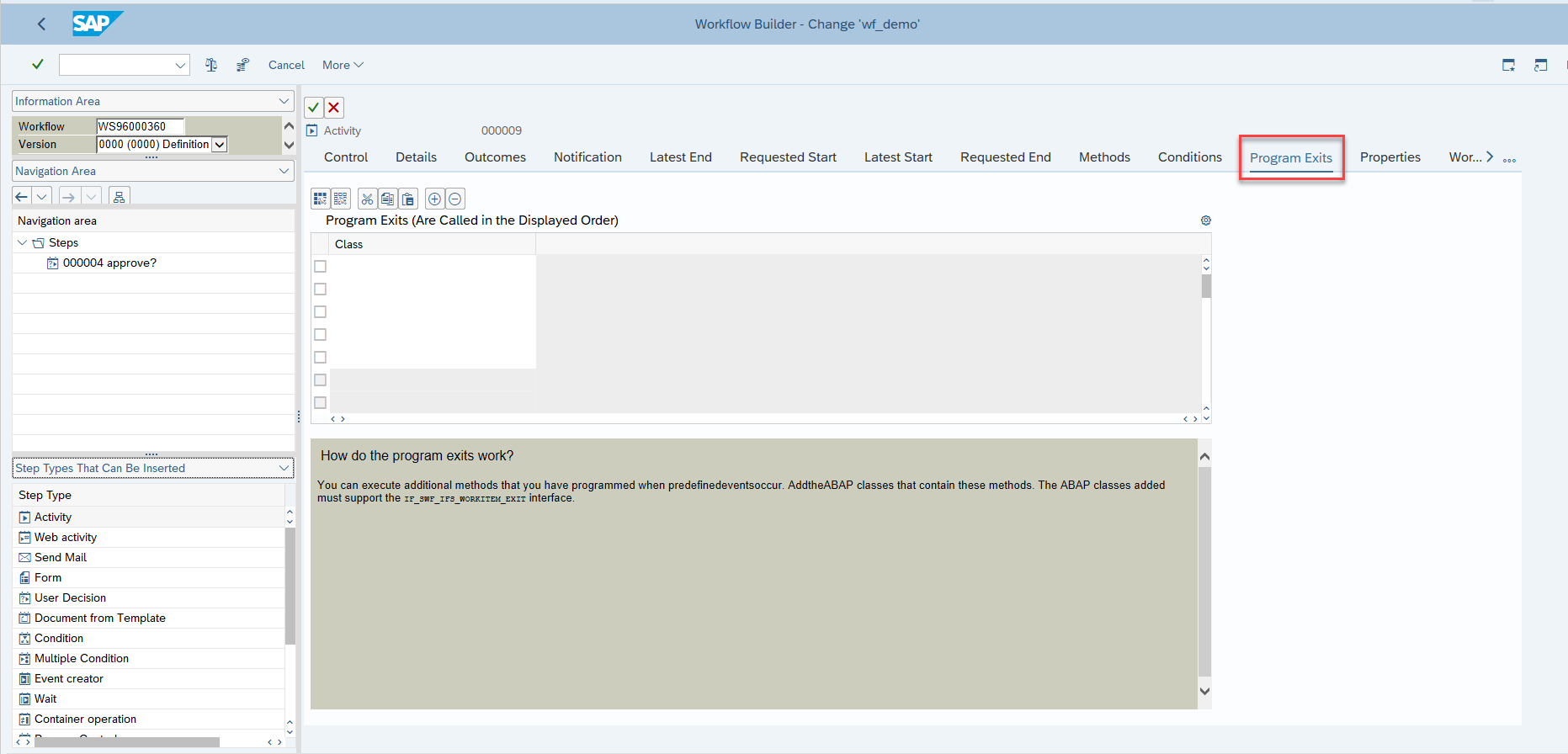Workflow. Sending Emails (2)
Workflow: Sending Emails to Dialog Task Processors
In this note, I’d like to share another method of sending an email to a dialog task processor within a workflow, which can be useful in project work.
See also: Workflow. Sending Emails
This time, the focus is on the Program Exits tab available when working with a task directly in the Workflow Builder (transaction SWDD).
See: Tab Page Programming Exits
You can enter programming exits on this tab page. A programming exit is an ABAP class that the system executes at a specific time during the processing of a workflow. Programming exits enable you to implement your own enhancements and adaptations.
To start using this workflow functionality, you must create an implementation class that supports the IF_SWF_IFS_WORKITEM_EXIT interface.
See: Tab Page Programming Exits
Features
ABAP classes that you specify here as programming exits must implement the interfaceIF_SWF_IFS_WORKITEM_EXIT. The system executes the classes in the specified order.
The methodEVENT_RAISEDis executed from every ABAP class as soon as the relevant work item performs a status change defined in the interface.

The method EVENT_RAISED is executed in each ABAP class as soon as the related work item undergoes a status change defined in the interface. Note that the implementation class can catch different states of the dialog task (see input parameter IM_EVENT_NAME).

Example
Preparing the Workflow
In the video snippet below, I show the sequence of steps where I create a workflow and several new elements in the workflow container. These elements will later be accessed in the class I’m creating before sending the email.
Implementation Class
For demonstration purposes, the source code of the class in this note is as follows:
METHOD if_swf_ifs_workitem_exit~event_raised.
DATA:
value_get TYPE char10,
lv_user TYPE sww_aagent,
lv_email TYPE string,
lo_document TYPE REF TO cl_document_bcs,
sender TYPE REF TO cl_sapuser_bcs,
lv_body TYPE string,
text TYPE bcsy_text,
send_request TYPE REF TO cl_bcs,
recipient TYPE REF TO if_recipient_bcs,
sent_to_all TYPE os_boolean.
DATA(lv_wi_id) = im_workitem_context->get_workitem_id( ).
DATA(lv_heaad) = im_workitem_context->get_header( ).
IF im_event_name EQ swrco_event_after_creation.
CLEAR value_get.
CALL METHOD get_elem(
EXPORTING
im_workitem_context = im_workitem_context
element_name = 'prm1'
IMPORTING
element_value = value_get
).
CLEAR value_get.
CALL METHOD get_elem(
EXPORTING
im_workitem_context = im_workitem_context
element_name = 'prm2'
IMPORTING
element_value = value_get
).
CLEAR value_get.
CALL METHOD get_elem(
EXPORTING
im_workitem_context = im_workitem_context
element_name = 'users'
IMPORTING
element_value = lv_user
).
IF lv_user IS NOT INITIAL.
CALL FUNCTION 'EFG_GEN_GET_USER_EMAIL'
EXPORTING
i_uname = lv_user+2
IMPORTING
e_email_address = lv_email
EXCEPTIONS
not_qualified = 1
user_not_found = 2
address_not_found = 3
OTHERS = 4.
IF sy-subrc <> 0.
lv_email = '[email protected]'.
ENDIF.
lv_body = 'mail from wi id #wi_id#'.
SHIFT lv_wi_id LEFT DELETING LEADING '0'.
REPLACE ALL OCCURRENCES OF '#wi_id#' IN lv_body WITH lv_wi_id.
APPEND lv_body TO text.
send_request = cl_bcs=>create_persistent( ).
lo_document = cl_document_bcs=>create_document(
i_type = 'HTM'
i_text = text
i_subject = 'mail from program exit' ).
CALL METHOD send_request->set_document( lo_document ).
sender = cl_sapuser_bcs=>create( 'WF-BATCH' ).
CALL METHOD send_request->set_sender
EXPORTING
i_sender = sender.
DATA lv_mail TYPE adr6-smtp_addr.
lv_mail = lv_email.
recipient = cl_cam_address_bcs=>create_internet_address(
lv_mail ).
CALL METHOD send_request->add_recipient
EXPORTING
i_recipient = recipient
i_express = 'X'.
CALL METHOD send_request->send(
EXPORTING
i_with_error_screen = 'X'
RECEIVING
result = sent_to_all ).
IF sent_to_all = 'X'.
ENDIF.
ENDIF.
ENDIF.
ENDMETHOD.
Finally, I add the created class to the Program Exits tab of the dialog task in the new workflow.